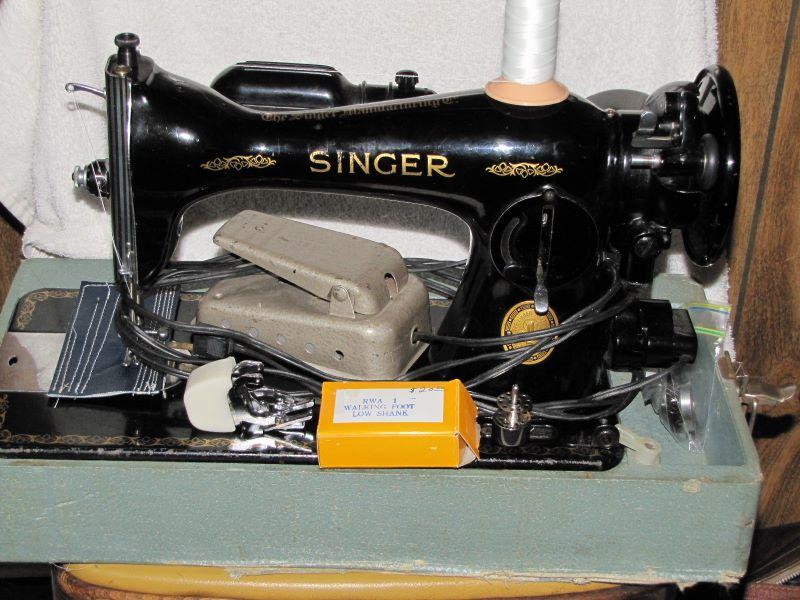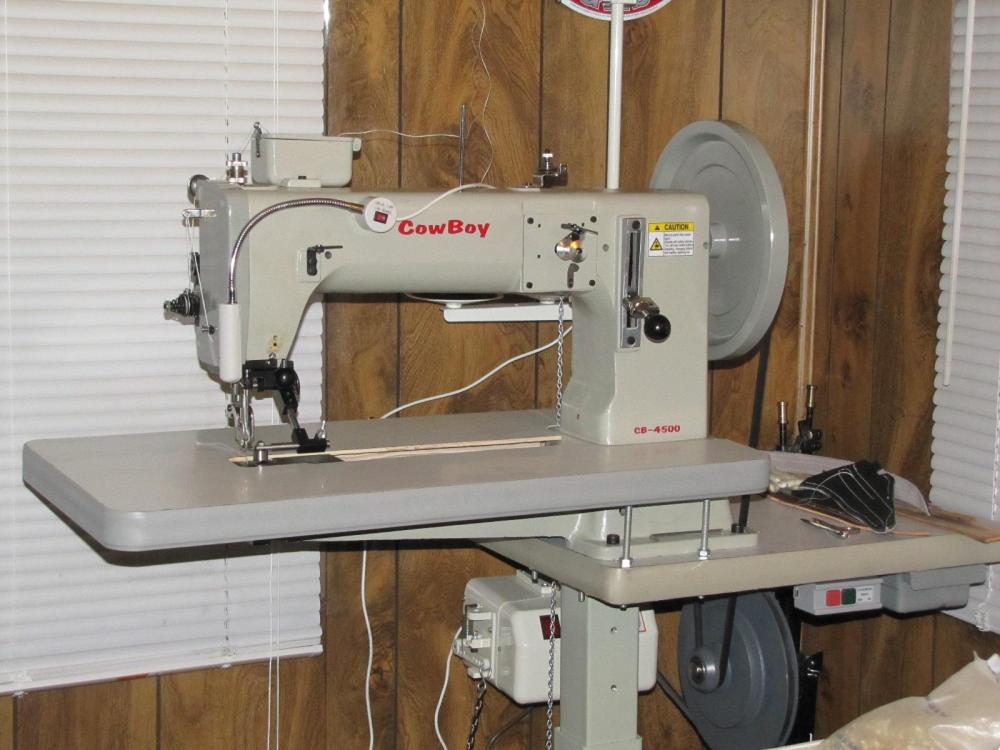-
Posts
7,715 -
Joined
-
Last visited
Content Type
Profiles
Forums
Events
Blogs
Gallery
Posts posted by Wizcrafts
-
-
Contact one of our Cowboy dealers. They can get any parts you need.
-
52 minutes ago, Cumberland Highpower said:
34 views and none tried?

We have links on the bottom of the page to read the next unread topic. Most of us just click on it and have no idea what the topic is until it opens. That's why so many views but no replies. Also, you are asking about an ancient machine that probably very few people have, or have had.
-
#138 bonded thread is best used when the thickness is about 6 to 7 ounces. This is due to the diameter of the lockstitch "knots." Since you are sewing a single layer of 3.5 ounces, the otherwise well hidden knots are showing on the top. You have three possible solutions to hide the knots in the single layer.
- Use one size smaller needle to have tighter holes that make it harder to pull the knots to the top.
- Tighten the bobbin and top tensions to have tighter knots that may be easier to center, or place lower inside the leather.
- Switch to #92 bonded thread which is much easier to bury in 3.5 ounces, while only losing 25% strength. You'll need a #19 or 20 needle for #92 thread.
-
That Landis 12 machine is a shoe sole stitcher. It will probably only be useful to a shoe repair shop, or maybe a new shoe maker. It only sews around outsoles, like on dress shoes and Cowboy boots. You could lookup all shoe repair shops within a couple hundred miles and see if one of them will come and get it.
-
Here is a topic about reducing the file size and posting photos on the forum. I personally use FastStone Photo Resizer to do this.
-
If you want to list this machine for sale, it needs to go into our Marketplace section, under sewing and stitching equipment > used. You will need to post better photographs of the business area of the machine and your asking price, plus the terms of sale and location.
Here is an example of a proper listing in the Used sewing equipment forum. Coincidentally, it is for the same make of machine you are dealing with.
-
-
Many monogramming shops are able to embroider onto leather jackets. You might check out a nearby embroidery shop to see what machines they use to do this. I am not up to date on the currently produced embroidery machines, other than Melco. I just saw a 10 needle, Husqvarna/Viking MN-1000 embroidery machine for sale at Joann Fabrics, in the Viking machine section. It looks good and sells for about 10k on sale (list is ~16k). The only concern I would have is the motor.
Here is a video about embroidery on chrome tan leather.
-
12 minutes ago, Constabulary said:
it for sure will get a decal - who do you think I'am?
 NB thread guide is back on too - found a couple of NOS guides.
NB thread guide is back on too - found a couple of NOS guides.
Did some testing yesterday - max. material thickness it can handle is 6.5mm - 7mm then the jump foot stops working but it still sews. But you cannot block the jump foot to stay static (as on Adler 4 / 5 machine) so practically this thickness is the max.. Maybe I can tweak it a bit more but I doubt!
I have a 1920s Singer 42-5 and no matter what I do it cannot sew more than 5/16 inch, which is about 8mm.
-
Here are some manuals for a Juki TSC-441. The CB3200 and its big brother the CB4500 are clones of the 441. While the 3200 has some differences in parts, the basics are the same. See if you can adjust the timing and lateral position of the shuttle and hook to get normal operation.
TSN-421 & TSC-441Engineer Manual.pdf
-
Move the needle clamp to the left until it clears the hook. Use the top screw on the clamp. Its hole is oblong to allow for sideways adjustment.
-
Most straight stitch machines, like the common Singer 31-15 and its offspring, can be converted into roller foot machines. The conversion kit includes a roller foot attachment, a special inline feed dog and a matching throat plate. The presser foot bar will probably need to be moved up to allow the roller to fully engage. There are small and large roller feet available.
-
For those curious about how side soles are sewn to uppers, here is an example of a sidewall sewing machine.
-
The 111 sub-class 150 is a needle feed, fixed foot machine. It will be fine for wallets and other flat seam sewing. If it encounters a tall seam, you will have to use the knee lifter to climb onto the higher level. It has a standard Singer G bobbin and can handle up to #138 bonded thread, but may like #92 better.
-
If you can't, or won't move the left hook assembly, try prying our the deflector tab a little to push the needle away from the hook. Most lockstitch machines pull the thread and needle to the left as they sew, which explains why that needle makes more contact than its right counterpart. I would personally try to move the left hook a smidgen. The timing gear can be tweaked later.
-
3 hours ago, Lucasn7 said:
For the scraping: i’ve tried different needles and only my thinner needles (size 80/12) do not scrape compared to the normal size i use. According to the manual size 130/21 should be okay. Any ideas for this?
You can move each hook drive laterally. There should be frames holding the hooks that can be moved by loosening big screws. There will also be a bendable deflector on each bobbin case that is supposed to push the needle ever so slightly out of harms way as the tip of the hook approaches it. If your hook tips have burrs, they need to come out and be buffed smooth again, or replaced.
-
You may have to fully convert the feed into a synchronized binder system. I strongly advise you to contact a Juki dealer. They will either already know, or can look up the list of parts needed for the conversion. Your machine may or may not have the basic required parts installed.
-
You are missing the throat plate that has notches to hold the bobbin cases in position!
-
-
It is a heavier than usual cloth sewing machine. It uses the same class 15 bobbin and shuttle as the 31-15.
-
Thanks Falker. They are part of history.
-
30 minutes ago, Frodo said:
I was only thinking about mounting a large treadmill DC motor and powering thru.
The motor would be more powerful than the feed system, negating its effectiveness. Drop feed dogs for cloth are quite fine. To grip and pull leather through calls for a much more aggressive tooth feeder. I sincerely doubt you will find a heavy duty feed dog and throat plate for that Brother machine.
-
That Brother is just a domestic/household cloth sewing machine with bottom feed. It may sew a few ounces of leather, but with thin thread. For instance, it may be able to sew thin wallet interiors, or possible entire wallets, not exceeding 6 to 7 ounces combined thickness. You may be able to change the foot to a Teflon plastic foot that lets the leather glide under it easier than the steel foot.
-
Mister Frodo;
You are asking about household/domestic sewing machines meant for cloth. Household (domestic) sewing machines are not meant to sew leather. Some can manage a few ounces, plus or minus. But, all of these machines are bottom feed only, via feed dogs and a fixed presser foot. The feed motion on the bottom has to fight against the downward force on top. Reducing the foot pressure leads to the leather lifting with the needle, causing skipped stitches and shredded thread. These machines may have little 0.5 to 1.5 amp motors (1/15 horsepower and under) on the back of the head and a speed control pedal on an AC cord that you set on the floor. Some may be inside a table that opens and closes, or sit in a hand held carrying case, or be mounted on a treadle base with a wooden top.
Leather sewing machines are usually mounted on industrial tables - 20" x 48" - with steel legs, or pedestal stands, and have large, very powerful motors under the table (from 1/3 to 3/4 horsepower). Most leather sewing machines have compound/triple feed, where the feed dog, needle and an inside foot move in sync while the outside presser foot simply moves up and down to clear or hold the leather. These machines can handle thread sizes way bigger than household machines and can sometimes sew as much as 3/4 inch of real leather.
The Singer 15 class below is NOT a leather sewing machine. The Cowboy IS a leather sewing machine.






Landis #1 and champion peerless 30
in Leather Sewing Machines
Posted
The problem with buying ancient sewing machines, especially those made for saddlery and harness, is that the companies have been out of business for many decades. Parts and accessories were sold off to dealers many years ago. Thus, if you buy a machine from the turn of the 20th Century and it needs a needle, shuttle, or a critical moving part, it may be made of Unobtanium.